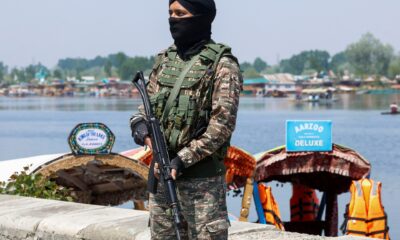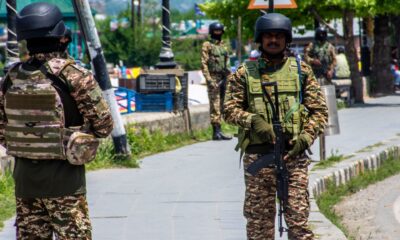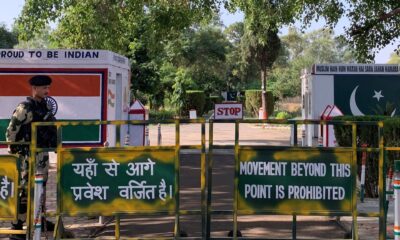Lifestyle
Chinese singles are looking for love in video chats — with thousands following along in real time

Steve Chen had never been in love. Last spring though, it happened. The 25-year-old met his first girlfriend in a way he couldn’t have imagined before: a livestreamed video chat.
Frustrated with traditional dating and using the apps, Chen jumped on a new trend among young, single people in China. Those looking for love go into video chatrooms hosted by what’s called a “cyber matchmaker,” all while thousands of viewers watch and comment in real time.
The number of single people in China over 15 reached a record-high of 240 million in 2023, according to government data. Facing a plummeting birth rate and an aging population, the government encouraged single people to marry and have multiple children. Last year, the State Council, China’s cabinet, mandated that local governments build various platforms for youth to have more opportunities to date.
“We should actively foster a new type of marriage and childbearing culture,” Chinese President Xi Jinping said in a speech in 2023, encouraging people to start families.
Shy and introverted, Chen found dating very hard. He used to describe himself as “mutai solo,” Chinese slang for single since in the mother’s womb.
But those days are over.
In a livestreamed video chatroom, Chen fell in love.
It was hosted by Tian Xin, a cyber matchmaker who has livestreamed virtual group dates on Xiaohongshu — or RedNote, a Chinese social media app — for over a year.
By day, Tian works at a tech firm. At night, she transforms into a matchmaker who breaks the ice, cracks jokes, moderates conversations and sometimes offers relationship advice. Her account has over 130,000 followers.
“Empathy is the most important thing. You need to be empathetic to what people say,” Tian told The Associated Press.
At 11 p.m. on a weeknight, over 800 viewers watched Tian’s video chatroom with background music of love-themed Chinese pop songs. Eight people were on camera, their faces arranged in a grid on the screen. Another dozen waited in a digital queue.
Tian started by asking each participant a similar set of questions: Age, weight, height, job, income, location, zodiac sign, hobbies and requirements for partners.
“Do you have a talent or skills to show us?” Tian asked one contestant, a PE teacher.
The man took off his shirt and flexed his biceps and six-pack abs. Mouths dropped open. Some clapped.
A new comment popped up in the chat with a series of laughing emojis: “Lol. Is dating so competitive these days?”
After the initial set of questions, participants chatted about their day-to-day lives and work as they went about their nightly routines — all on camera. One person washed off her makeup while another ate a late-night dinner of fried chicken.
As a medical student doing his residency, Chen said he had little free time to date. “The pressure of study and work is very strong. I don’t have time to socialize with people and make friends.”
Chen is not alone in feeling this way. Over 30% of young people who are single said it’s because of their busy work schedules, according to a 2025 report from iiMedia Research, a Chinese data analysis agency. Many companies in China ask employees to work 12-hour days, six days a week. In response, there’s a growing trend of ” lying flat,” or working as little as possible — and choosing to remain single — to resist societal pressures.
For those who want to get married though, the livestreamed videos are an appealing alternative to traditional matchmaking methods, like marriage markets — where families exchange resumes and arrange dates for their unmarried children.
They’re also another option for those tired of dating apps.
Christine Zhang said the livestreamed videos are more fun and interactive than the apps.
“You can see more than just photos on profiles in livestreams. You can see how one person speaks and acts,” Zhang said.
She started regularly tuning into Tian’s livestream, where Chen — also a regular— caught her eye. He sometimes danced and sang in front of the camera.
In front of hundreds of viewers on the livestream, Zhang shared that she had a crush on him. Other participants, along with an audience of hundreds of followers, were impressed by her courage. The matchmaker introduced them and encouraged them to talk one-on-one off the livestream. They texted and met up in person several months later.
Nearly a year later, the two are in a serious relationship.
They both said they feel lucky to have met.
“Finding love is hard. I had to muster the courage to share my feelings in front of the camera,” Zhang said. “I think only those who are brave find love.”
Lifestyle
End of Vietnam War is still deeply felt by some Americans

ANCHORAGE, Alaska (AP) — The Vietnam War greatly impacted U.S. society from the passage of the War Powers Resolution that restricts the president’s ability to send troops into extended combat without congressional approval to the cementing of college campuses as centers of student activism.
Millions of U.S. troops fought in Vietnam. For some Americans, the war that effectively ended with the fall of Saigon 50 years ago Wednesday on April 30, 1975, continues to shape their lives.
They include: A woman dedicated to recovering her father’s remains after the bomber he piloted disappeared over Vietnam’s Gulf of Tonkin. A Vietnam veteran who was heckled like scores of other troops when he returned home and now assists fellow veterans in rural Alaska. And an anti-war movement stalwart who has spent decades advocating for free speech after her brother was wounded when Ohio National Guard troops fired into a crowd of protesters at Kent State University.
Here are their stories.
This photo provided by Jeanie Jacobs Huffman shows her, right, with Principle Deputy Director of Defense POW/MIA Accounting Agency Fern Sumpter Winbush, left, during an unveiling ceremony for the 2025 National Recognition Day poster. (Dave Huffman/Jeanie Jacobs Huffman via AP)
Still waiting for dad to return home
Fifty years after the fall of Saigon, Jeanie Jacobs Huffman has not lost hope of bringing her father home.
Huffman was only five months old when her father, Navy Cdr. Edward J. Jacobs Jr., was reported missing in action after the plane he was piloting to photograph enemy targets vanished in 1967 over the Gulf of Tonkin, off the coast of North Vietnam.
Huffman has dedicated her life to finding the plane and recovering his remains and those of his two crew members. She also serves on the board of directors of Mission: POW-MIA, a nonprofit group dedicated to finding unaccounted Americans from past conflicts.
“It’s a lot of missing, you know, a huge void in my life,” she said, breaking into tears.
A professional photographer, Huffman has made a poster featuring the faces of the 1,573 missing service members from Vietnam.
“After this many years, we should never leave anyone behind,” she said.
This photo provided by Jeanie Jacobs Huffman shows her on the beach in June 2024, two miles away from where her father’s plane and crew were discovered in 70 feet of water, in Thanh Hoa Province, Vietnam. (Dave Huffman/Jeanie Jacobs Huffman via AP)
A year ago, she visited the Gulf of Tonkin through a trip with the United States Institute of Peace, a nonprofit that promotes education and research on conflicts to prevent future wars. The group’s translator, who was from North Vietnam and also lost family members in the war, walked with Huffman into the water. Holding hands, they both cried, sharing their grief.
“So that was the closest I’ve been to him in 58 years,” Huffman said of her father.
She’s pushing for the Defense POW/MIA Accounting Agency to conduct an underwater search operation next year in hopes of recovering the plane. The U.S. Department of Defense agency is responsible for recovering and identifying service members listed as missing in action or prisoners of war.
“He deserves to be brought back home,” she said. “Even if it’s just a bone or a dog tag. Even the tangible things, like a dog tag or a piece of his plane, mean a lot to me because I don’t have anything else.”
This photo provided by George Bennett shows Bennett during his service in Vietnam from 1966 to 1967. (George Bennett via AP)
Finding salvation after so many decades
For George Bennett, the road to sobriety and mental health continued long after flying home through San Francisco in 1968, where “sneering” protesters met returning soldiers in the terminal.
Someone yelled out, “baby killer.” Another spit at them. He and his fellow soldiers were turned away from one airport restaurant.
Only later did he realize how much Vietnam had changed him because the war went against the strict sense of values and Indigenous practices instilled by his parents.
George Bennett stands in front of a totem on the Southeast Alaska Health Consortium campus in Sitka, Alaska, Monday, April 28, 2025. (James Poulson/The Daily Sitka Sentinel via AP)
This photo provided by George Bennett shows Bennett with children from the Dau Tieng village during his service in Vietnam from 1966 to 1967. (George Bennett via AP)
A member of Alaska’s Tlingit tribe, Bennett said, “I would go get my beer and come home … just drink beer and do nothing.”
“I think part of it was the fact that I was ashamed and guilty because I was part of the atrocity that occurred in Vietnam. I feel that I violated the value and some of our cultural norms, and it made me want to run.”
And he did, from bar to bar and job to job.
Finally, he wound up receiving help for alcoholism and post-traumatic stress disorder.
It’s taken him 30 years to feel better, largely because of the support of Mary, his wife of 55 years. She insisted they move to the southeast Alaska city of Sitka, where he has integrated back into his native Tlingit culture.
He’s now Alaska’s sole rural veteran liaison, helping veterans secure benefits in the military’s health care system.
“I really had to find my spiritual way again,” he said. “It took me a while to get there, but here I am.”
Chic Canfora recounts the events of May 4, 1970, standing at the pagoda where National Guardsmen knelt and shot towards students in the parking lot at rear, during an interview Thursday, May 2, 2024, in Kent, Ohio. (AP Photo/Sue Ogrocki, File)
Kent State University protester sees lessons for today
Chic Canfora still becomes emotional when she talks about the fall of Saigon.
Canfora was part of an anti-war protest at Kent State University in 1970 when Ohio National Guard troops fired into the crowd, killing four fellow students and wounding nine others, including her brother. The bullets sent Canfora diving for cover.
She believes the protest helped galvanize public opinion that would hasten the withdrawal of U.S. troops and ultimately lead to the fall of Saigon and the war’s demise.
A decade ago, Canfora visited the Vietnam Veterans Memorial Wall in Washington and was overcome at seeing how the number of names of the fallen dwindled after 1970.
“That was the first time it really hit me the impact of the anti-war movement and, so it’s particularly meaningful for me this year,” she said, choking up.
Canfora, who teaches journalism at Kent State, has spent her life sharing what she experienced. She said the lessons learned are more relevant than ever amid the Trump administration’s crackdown on student protesters, fears of deportation for international students and what critics describe as unprecedented attacks on campus speech.
A general view shows tear gas and students during an anti-Vietnam war protest at Kent State University in Kent Ohio, May 4, 1970. U.S. National Guardsmen opened fire during the protests killing four students and wounding five. (AP Photo/Larry Stoddard, File)
She said she sees echoes of the past when then Ohio Gov. James Rhodes, who sent in the National Guard, called the Kent State demonstrators “the worst type of people that we harbor in America.”
“I was too young and too naive to recognize the danger of such inflammatory rhetoric because, in essence, all of these leaders in our country were putting targets on the backs of American college students who have historically served as the conscience of America,” Canfora said.
“I think students today are going through that same metamorphosis of awareness that I did in 1970.”
___
Watson reported from San Diego.
Lifestyle
Danish king arrives in Greenland as Trump eyes strategic Arctic island

NUUK, Greenland (AP) — King Frederik X of Denmark arrived in Greenland on Tuesday, kicking off a visit to the semiautonomous territory that U.S. President Donald Trump wants to annex because of its strategic Arctic location.
Frederik’s trip to the island’s capital city of Nuuk follows the new Greenlandic prime minister’s visit to Copenhagen earlier this week. Prime Minister Jens-Frederik Nielsen accompanied the monarch to Nuuk.
The king wore a jacket with emblems of the Danish and Greenlandic flags as he disembarked from the plane to applause.
Danish broadcaster TV2 asked Frederik about his mission during his trip. He said he wasn’t on a mission, and he was happy to be there.
Nielsen also told reporters that the Danish royal house’s love for Greenland can’t be questioned. He added that the monarch is well-liked on the island.
The flight was originally scheduled for Monday, but was delayed because of poor weather conditions.
Frederik is expected to meet with the new Greenlandic government this week, as well as attend a traditional “kaffemik,” or coffee break, to meet with Greenlanders, the royal house said.
Weather forced him to cancel the anticipated trip on Wednesday to Station Nord, the island’s northernmost military and scientific station, plus forgo a meeting with an elite dogsled unit of the Danish special forces that patrols the remotest parts of northeast Greenland.
The monarch visited Greenland last July, months after he took the Danish throne upon his mother’s abdication.
This week’s Greenland trip comes after U.S. Vice President JD Vance visited a remote U.S. military base on the island and accused Denmark of underinvesting in it. Trump seeks control of mineral-rich Greenland, saying it’s crucial for U.S. security. Trump hasn’t ruled out taking the island by military force, even though Denmark is a NATO ally of the United States.
Lifestyle
The secret to a refreshing cocktail or mocktail might be out in the garden

If you enjoy a tasty, refreshing summer cocktail or mocktail, why not grow your own?
No, you’re not likely to grow the spirits — although they do come from plants (vodka from potatoes, tequila from agave and so on). But you can grow other ingredients that make those spirits delicious.
Tips for growing mint and other flavorful herbs
Mint is the easiest herb to grow. It’s so easy it may take over your garden if you aren’t careful, so plant it in a pot and keep the pot away from the soil. Place the pot in full sun and water it regularly. In a few short weeks, you’ll be able to pluck its leaves to liven up your lemonade or mint julep.
If you want to get creative, experiment with a few different varieties. My favorite is spearmint, but peppermint is classic. Chocolate mint, pineapple mint and apple mint each have their charms, named for the scents and flavors they impart. There’s even a specialty variety called Cuban mint, an authentic choice for mojitos.
Basil, too, is available in several cocktail-worthy varieties. Genovese, the Italian variety often paired with tomatoes, works equally well in beverages, as do lemon and cinnamon varieties. Plant them in full sun and provide water, but account for your climate and take care not to over- or underwater them. Remove flower stalks, if they appear, to prevent the leaves from turning bitter.
Lemon verbena smells heavenly and pairs as well with a gin and tonic as it does with sparkling water. Most herbs don’t usually require supplemental nutrients, but lemon verbena benefits from monthly applications of organic liquid fertilizer. Water plants when the soil begins to dry out; overwatering may lead to root rot.
When I have guests, I often muddle sage leaves with 1 ounce each of vodka and ginger liquor, then add to a glass with 4 ounces of ginger beer, and pineapple and lime juices to taste. It’s as simple as can be — and just as impressive.
For the most concentrated flavor, harvest herbs in mid-morning, after the dew has dried but before the sun gets too hot. In my garden, that means around 10 a.m. Place them, stem side down, in a glass of water indoors, out of direct sunlight, until happy hour.
Strawberries, cucumbers and heat
Don’t forget the strawberries (bonus: The plants come back every year in horticultural zones 4-9) and cucumbers, both mandatory components of a proper British Pimm’s cup, one of my favorite summertime cocktails.
I make mine by packing a highball glass with thinly shaved cucumber, sliced strawberries, mint and a couple of sliced mandarin rounds, then topping it with 1 1/2 ounces of Pimm’s No. 1 liquor and 4 ounces of lemonade or lemon-lime soda.
And if you like your drinks spicy, muddle a red-ripe slice of jalapeno with lime juice and pour a shot of tequila over it, then add your choice of mixer. Or drink it straight. I’m not judging you. I’m just the garden lady.
___
Jessica Damiano writes weekly gardening columns for the AP and publishes the award-winning Weekly Dirt Newsletter. You can sign up here for weekly gardening tips and advice.
___
For more AP gardening stories, go to https://apnews.com/hub/gardening.
-

 Middle East2 days ago
Middle East2 days agoSaudi Arabia, Qatar to settle Syria’s outstanding debt to World Bank | Business and Economy News
-

 Middle East1 day ago
Middle East1 day agoDeadly US strike hits Yemeni migrant centre | Israel-Palestine conflict News
-

 Conflict Zones2 days ago
Conflict Zones2 days ago‘Burst balloon’: How Pahalgam attack shattered Modi’s Kashmir narrative | Narendra Modi News
-

 Middle East2 days ago
Middle East2 days agoSudan Doctors Network accuses RSF of ‘war crimes’ after 31 killed | Sudan war News
-

 Middle East1 day ago
Middle East1 day agoFires continue to rage at key Iran port as explosion death toll rises to 46 | Oil and Gas News
-

 Lifestyle2 days ago
Lifestyle2 days agoHow bugs and beet juice could play roles in the race to replace artificial dyes in food
-

 Conflict Zones1 day ago
Conflict Zones1 day agoIndia and Pakistan continue to trade fire across Kashmir border | Conflict News
-

 Conflict Zones1 day ago
Conflict Zones1 day agoKashmir attack: Why Pakistan’s threat to suspend Simla Agreement matters | Conflict News




